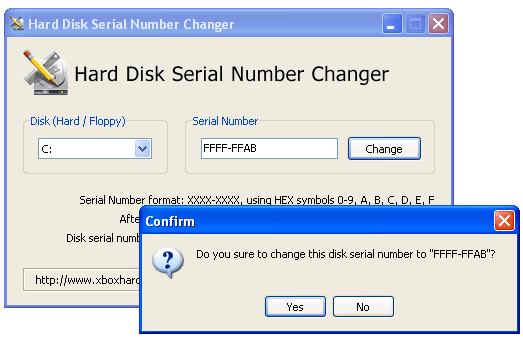Change Sd Card Serial Number Windows

Hard Disk Serial Number Changer, free and safe download. Hard Disk Serial Number Changer latest version: Change your hard drive serial number effortlessly!. This free to download application is an easy to carry and light program that confers users with t. Iterating on my precedent post, the next logical step is to use the USB interface to access the SD card connected to the Teensy2/ATMEGA32U4 with a Mass.

README.md evoplus_cid Tool to change the CID on Samsung Evo Plus SD Cards. Requires rooted Android device. Precompiled Android binary included. May also work on regular Linux, but you must use a real sd controller, not a usb mass storage type sd reader. See for more details.
USE AT YOU OWN RISK! Usage:./evoplus_cid [serial] device - sd card block device e.g. /dev/block/mmcblk1 cid - new cid, must be in hex (without 0x prefix) it can be 32 chars with checksum or 30 chars without, it will be updated with new serial number if supplied, the checksum is (re)calculated if not supplied or new serial applied serial - optional, can be hex (0x prefixed) or decimal and will be applied to the supplied cid before writing Based on the reverse engineering and code of Sean Beaupre, see.
Hello, I prepared instalation which is useable for me and then I created with Win32 Disk Imager like backup/clone img file. It was used for next same application (new raspberry Pi´s) but now I had a problem with write it to new SD memory card (same vendor, type and serial number).
New memory card capacity is smaller like old one (you can see in attached picture). How can be possible write existing img file to new smaller memory card? Attachments Disk_Imager.jpg (23.36 KiB) Viewed 22122 times. ShiftPlusOne wrote:Or maybe someone knows a simpler way.
Not on Windows, but someone (sorry, I can't remember who) has written a Linux script that will resize the saved image file to make it as small as possible. That would be asb's shrink_image, which is a part of spindle. It's a little messy though and may require a small tweak or two to get it to work. Instasize Download Apk here. I've used it a fair few times and have my own script which takes an image, creates another one of a defined size and then rsyncs the files from one to the other. System32 Ntoskrnl Exe Download Free. Stevejferry wrote:Hi Guys, I have the same problem. I have my OS on a standard 8Gb SD card but have bought an 8Gb micro SD and adapter for the Pi. I can't write the image from the old card to the new one because Win32 Disk Imager says its too small.
And here's me thinking all 8Gb cards were 8Gb! If somebody can post an easy solution to this (without needing Linux), they'd be a god(ess) in my eyes! Regards, Steve.
Use a gparted livecd or a VM with a usb sd card reader. Once you get to that point, you can either dd (there's a windows version) or snip the end off the file and use win32diskimager.
But there's no easy way to do it from windows. Windows is just not made to do these things. Stevejferry wrote:And here's me thinking all 8Gb cards were 8Gb! Nah, unfortunately not, which catches out a lot of people!
From my own testing, I've found cards which are 'nominally' labelled as the same size can actually be several hundred megabytes different My current smallest '8GB' card is 7384MB and my current largest card '8GB' card is 7695MB - and I'm sure there's no doubt larger and smaller '8GB' cards in the wild. And obviously the larger the nominal capacity of the card, the larger these discrepancies become. Considering how flash memory works, its not surprising they vary in size. In easy terms, flash is difficult to make 'perfect' so they make it as it comes, imperfections and all, attach a small microprocessor to manage it and isolate the rough bits and hey presto they can sell almost all of the flash they make.
Its how fake cards are made, they reprogram the microprocessor to report a false size and they use what they have available working normally, when the card runs out of actual flash, the data disappears into the ether, the card pleads ignorance and the owner is left scratching his head. AndrewS wrote:Yeah, that's what I used to think, which would suggest that every SD card has a different size, based on how many bad sectors its flash happens to have. And yet whenever I've bulk-bought a batch of identical SD cards (same manufacturer/make/model/etc.) they all have exactly the same size? Possibly they do a quick test on a batch and bulk program them all to match the lowest working capacity (minus a bit to allow for recovery blocks), rather than having to take time to program each card individually?